 Why You Can Trust CNET
Why You Can Trust CNET Klipsch Icon SB 1 Soundbar review: Klipsch Icon SB 1 Soundbar
The Klipsch Icon SB 1 delivers good sound quality in a convenient package, but lacks some of the connectivity expected at this price level.
The Klipsch Icon SB 1 is a soundbar/wireless subwoofer combo. It draws upon Klipsch's origins back in the immediate post war (WW2, that is), with horn loaded tweeters. Some quite inconvenient laws of physics make it difficult to turn electrical power into acoustical power. So a typical loudspeaker (one with a sensitivity of 89dB) will turn about 0.5 per cent of the input power into sound, while the rest becomes heat. Horns improve the match between the physical impedance of air, and that of the speaker cone, and therefore increase efficiency. A highly efficient horn-loaded loudspeaker system might run to as much as 20 per cent of the input power being converted to sound.
The Good
The Bad
The Bottom Line
The horns over the 20mm tweeters in this Klipsch soundbar — and you can actually inspect them, because the cloth grilles are removable — are fairly shallow, so they are unlikely to increase efficiency all that much. But even a little helps. Midrange is carried by, for each of the left and right channels, two 76mm drivers. Bass is sent wirelessly to a subwoofer.
The sub is an unusual unit. Rather than being roughly cubical, it is quite narrow, but deep. On one side is a remarkably large driver: a full 254mm woofer. The enclosure is bass reflex loaded, with a slotted port at the back, near the level control.
The soundbar itself is reasonably wide at just a touch over a metre. It is narrow and not too tall (112mm) and has slots on the back for wall mounting. A pair of feet are also provided for putting the bar on a bench in front of a TV. Analogue stereo (via a pair of RCA sockets) and optical digital audio inputs are provided. Perhaps surprisingly, given that the pricing puts this unit in the premium space, Bluetooth isn't available. A small six button remote is provided for controlling the system, but you can also program it to operate with your regular TV's remote control.

(Credit: Klipsch)
In Use
The subwoofer is pre-paired to the soundbar so all you need to do is plug everything in. I put the subwoofer in my standard subwoofer room corner, and the bar on a bench in front of a TV.
It is important to put the subwoofer into balance with the soundbar. There's a level control on the back of the subwoofer for that purpose. I used a stereo test tone and a Sound Pressure Level meter to make sure it was right. If you don't have those, I'd suggest you use some stereo music with which you are very familiar — something with decent bass — and adjust the subwoofer's level until it sounds right.
I've been using a lot of soundbars lately, and after looking at a dozen or so, some with subwoofers, it was really nice to experience sound with a real subwoofer, with real deep bass. It was instantly noticeable, the moment I started playing some music. The fundamental frequencies of a kick drum (40 hertz or so) were there at full strength. So was most of the bottom octave on a piano (the leftmost key, A, on an 88 note keyboard has a fundamental frequency of 27.5 hertz). It wasn't a matter of the sound making me feel like that the bass was well balanced, but that it actually was, right down into the solidly deep regions.
The soundbar itself sounded very good combined with the subwoofer. The tonal balance was excellent and the dynamic performance — the ability to punch out audio peaks in the midst of other loud content — was also very strong. It was a pleasure to listen to the jazz stylings of Weather Report with this system.
Movie sound was also clear. The unit proved to support multichannel Dolby Digital sound in addition to stereo PCM fed via optical digital. It even handled 24 bit, 96kHz PCM. But with the Dolby Digital, it quite ignored the LFE channel, which is bit of a pity given the strong capabilities of the subwoofer that comes as part of the system.
There is what purports to be a surround mode invoked by means of the 3D control key. This mode did tend to widen the front audio stage a little, but at the cost of imposing an unrealistically honky lower treble on the sound, removing the rather natural-sound virtues of the bar in its two channel mode. What it didn't do was generate anything approaching immersion into a surround sound field, so it's something best avoided.
But leaving that off, the system went pleasingly loud, with clear dialogue on movies, and a clean sound stage on music.
My impressions were confirmed when it came to the bass performance. Measured up close, the 254mm subwoofer delivered cleanly all the way down to 30 hertz. That's actually deep enough to encompass the deepest C pedal of most large pipe organs (32 hertz).
Conclusion
The Klipsch Icon SB 1 soundbar is ideal for those who want high quality sound with strong and extended bass, and don't care so much for extra features like Bluetooth connectivity.


